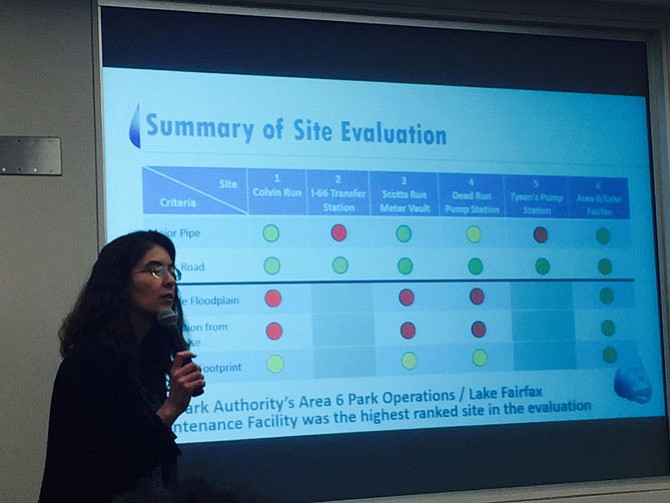Engineer Ellen Hall alerts Reston residents why Lake Fairfax Park is the most suitable location of the six studied for a septage receiving site. Photo by Ken Moore.
Reston’s Richard Sheehe asked on Feb. 18 if Reston residents could be assured that the county would suspend work on preliminary designs to move the county’s Septage Receiving Site from Colvin Run in Great Falls to a maintenance portion of Lake Fairfax Park in Reston.
“Will the county agree to suspend any work on preliminary designs and revise the next steps to review and expand the feasibility study?” Sheehe asked. “Do we have that assurance?”
“Yes,” said Thomas J. Russell, director of the Wastewater Collection Division.
Dranesville Planning Commissioner John Ulfelder also said to the engineers and officials in February, “It’s clear tonight you have to broaden your feasibility study to look at non-public sites.”
Hunter Mill Supervisor Cathy Hudgins sent a letter last week alerting Reston residents that the county will look at additional locations for a septage receiving site, including non county-owned land.
“Attendees overwhelmingly expressed dissatisfaction with the proposed relocation to Lake Fairfax Park and voiced multiple concerns including but not limited to the impact to the various communities and Hunter Mill Road.”
— Supervisor Cathy Hudgins (D-Hunter Mill)
“Attendees overwhelmingly expressed dissatisfaction with the proposed relocation to Lake Fairfax Park and voiced multiple concerns including but not limited to the impact to the various communities and Hunter Mill Road,” according to Hudgins.
DRANESVILLE SUPERVISOR John W. Foust said he was sympathetic to concerns of Reston’s residents.
“That would have been a huge mistake,” he said, of the potential plans to move the septic receiving site to Lake Fairfax.
“I’m glad that site did not materialize and glad that the county will shut down the Colvin Run Receiving Facility,” said Foust.
“Hunter Mill Road is a fairly historic highway, narrow and very heavily traveled and to intentionally divert truck traffic on that road is not a good idea,” he said. “Accessing it would have created problems.”
The Colvin Septage Receiving Site will be closed for safety reasons during construction for at least two years, for reasons unrelated to the relocation, Hudgins said.
The Department of Public Works and Environmental Services (DPWES) with consultant Hazen and Sawyer shared a feasibility study that identified six potential sites for the relocation of the Colvin Run Septage Receiving Site.
Lake Fairfax Area 6 Park Operations/ Maintenance facility site received the highest ranking.
The Reston community was outraged.
According to Hudgins, “The Department of Public Works and the consultant committed to addressing the various concerns raised and will also extend the potential relocation search area to properties not owned by Fairfax County.
“Hazen and Sawyer is in the process of establishing a scope and schedule for responding to this commitment by the end of April. All activity associated with the feasibility of relocating the Colvin Run Septage Receiving Site to Lake Fairfax is on hold at this time,” according to Hudgins.
Septage is currently accepted at both the Colvin Run site for the north county and the Norman M. Cole Jr. Pollution Control Plant in Lorton.
“My expectation is we won’t be building a new site. We’ll see how this works out,” said Foust. “If something unanticipated comes up, we may have to go to the drawing board.”
ABOUT 21,000 customers in Fairfax County don’t have access to public sewer and are served by individual household septic systems that require “pump-out” every five years. Approximately 49 percent of the sewage generated in the county is from septic tanks. Approximately 3,200 food service establishments require collection from grease traps. The county’s septage management program also collects waste from portable toilets at parks, construction sites, community events and races.

